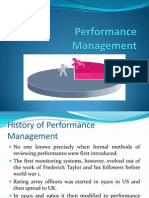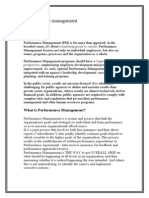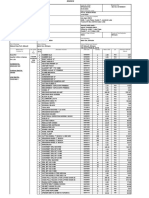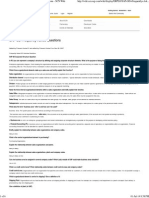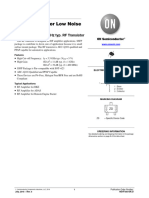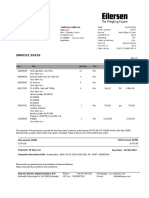Click Here Definition of Performance Management
Uploaded by
Hansa YadavClick Here Definition of Performance Management
Uploaded by
Hansa YadavDefinition of Performance Management
You must have a clear and practical definition of performance management if you want to purposefully manage the performance of your direct reports in order to lead them to peak performance. We do not define anything here in terms of theory we define everything here according to the practical needs of the manager who must deliver results through her direct reports. Before we ask ourselves what is performance management, lets define the meaning of performance. Performance is the sum of behavior plus results: Performance = Behavior + Results When you are looking at performance, it is necessary to focus on both, on behavior and on results: If you only focus on behaviors, you wont notice if you dont get desired results And if you only focus on results, you wont notice if your employees dont behave ethically Remember this simple formula its very easy to recall it and it is extremely useful. The definition of performance management then, is the systematic and periodic assessment of your direct reports behaviors and results. Now, despite the fact that this definition of performance management is accurate and objective, it is useless. This definition by itself wont help you get very far in managing the performance of your employees. Together with this definition of performance management, you also need to know what performance management is for. Performance Management Goals What is performance management for? In other words, what are the goals of performance management? Performance management has two goals: The first goal is to create competency in your people competency refers to the adequate skills your direct reports need in order to achieve desired performance. The second goal is to create growth in your employees growth refers to the development of skills of your direct reports in order to exceed desired performance and be able to move to increasingly difficult assignments. Translation number one: Performance management means that your job as the boss is two-fold: First, it is to help your direct reports be able to do current tasks; and second, it is to help them grow professionally. The more you do this well, your team will become gradually stronger, and your team will deliver better results. Translation number two: As the manager that you are, doing performance management well will help you grow as a leader tremendously (to lead among other tasks is to grow people). Since you get paid to deliver results, from your own perspective and from the organization you work for perspective, performance management is not an option. Translation number three: Performance management is an ongoing process. Performance management is not a once in a while one-time event like performance appraisal for example if it were, it would be impossible to achieve your two performance management goals. By keeping these two elements (definition of performance and the two performance management goals) in your definition of performance management, you will maintain objectivity and effectiveness in your performance management endeavors, and consequently, you will be able to boost the performance of your direct reports. To keep on learning about performance management, go back to the previous page ( or reading in a sequential order. If you would like to learn about our definition of performance services for your organization, please click on this link.
click here ), and continue
managementthrough our speaking or consulting
Performance management is the process of creating a work environment or setting in which people are enabled to perform to the best of their abilities. Performance management is a whole work system that begins when a job is defined as needed. It ends when an employee leaves your organization. Many writers and consultants are using the term performance management as a substitution for the traditional appraisal system. I encourage you to think of the term in this broader work system context. A performance management system includes the following actions. Develop clear job descriptions. Select appropriate people with an appropriate selection process. Negotiate requirements and accomplishment-based performance standards, outcomes, and measures. Provide effective orientation, education, and training. Provide on-going coaching and feedback. Conduct quarterly performance development discussions. Design effective compensation and recognition systems that reward people for their contributions. Provide promotional/career development opportunities for staff. Assist with exit interviews to understand WHY valued employees leave the organization.
Performance management is the process of creating a work environment or setting in which people are enabled to perform to the best of their abilities. Performance management is a whole work system that begins when a job is defined as needed. It ends when an employee leaves your organization. Many writers and consultants are using the term performance management as a substitution for the traditional appraisal system. I encourage you to think of the term in this broader work system context. A performance management system includes the following actions. * Develop clear job descriptions. * Select appropriate people with an appropriate selection process. * Negotiate requirements and accomplishment-based performance standards, outcomes, and measures. * Provide effective orientation, education, and training.
* Provide on-going coaching and feedback. * Conduct quarterly performance development discussions. * Design effective compensation and recognition systems that reward people for their contributions. * Provide promotional/career development opportunities for staff. * Assist with exit interviews to understand WHY valued employees leave the organization.
Performance management (PM) includes activities that ensure that goals are consistently being met in an effective and efficient manner. Performance management can focus on the performance of an organization, a department, employee, or even the processes to build a product or service, as well as many other areas. Performance management as referenced on this page is a broad term coined by Dr. Aubrey Daniels in the late 1970s to describe a technology (i.e. science imbedded in applications methods) for managing both behavior and results, two critical elements of what is known as performance
It may be possible to get all employees to reconcile personal goals with organizational goals and increase productivity
and profitability of an organization using this process.[2] It can be applied by organisations or a single department or section inside an organisation, as well as an individual person. The performance process is appropriately named the selfpropelled performance process (SPPP)
Benefits Managing employee or system performance facilitates the effective delivery of strategic and operational goals. There is a clear and immediate correlation between using performance management programs or software and improved business and organizational results. For employee performance management, using integrated software, rather than a spreadsheet based recording system, may deliver a significant return on investment through a range of direct and indirect sales benefits, operational efficiency benefits and by unlocking the latent potential in every employees work day (i.e. the time they spend not actually doing their job). Benefits may include: Direct financial gain
Grow sales Reduce costs in the organization Stop project overruns Aligns the organization directly behind the CEO's goals Decreases the time it takes to create strategic or operational changes by communicating the changes through a new set of goals
Motivated workforce Optimizes incentive plans to specific goals for over achievement, not just business as usual Improves employee engagement because everyone understands how they are directly contributing to the organisations high level goals Create transparency in achievement of goals High confidence in bonus payment process Professional development programs are better aligned directly to achieving business level goals Improved management control Flexible, responsive to management needs Displays data relationships Helps audit / comply with legislative requirements Simplifies communication of strategic goals scenario planning Provides well documented and communicated process documentation
[edit]Organizational
Development
In organizational development (OD), performance can be thought of as Actual Results vs Desired Results. Any discrepancy, where Actual is less than Desired, could constitute the performance improvement zone. Performance management and improvement can be thought of as a cycle: 1. Performance planning where goals and objectives are established 2. Performance coaching where a manager intervenes to give feedback and adjust performance 3. Performance appraisal where individual performance is formally documented and feedback delivered A performance problem is any gap between Desired Results and Actual Results. Performance improvement is any effort targeted at closing the gap between Actual Results and Desired Results. Other organizational development definitions are slightly different. The U.S. Office of Personnel Management (OPM) indicates that Performance Management consists of a system or process whereby: 1. Work is planned and expectations are set 2. Performance of work is monitored 3. Staff ability to perform is developed and enhanced 4. Performance is rated or measured and the ratings summarized 5. Top performance is rewarded[3]
[edit]
Organizational Performance Management -- Evaluating and Improving Organizations
Copyright Carter McNamara, MBA, PhD, Authenticity Consulting, LLC. We're used to thinking of ongoing performance management for employees, for example, setting goals, monitoring an employee's achievement of those goals, sharing feedback with the employee, evaluating the employee's performance, rewarding the employee's performance or firing the employee. However, performance management applies to teams and organizations, as well. Organizational performance involves the recurring activities to establish organizational goals, monitor progress toward the goals, and make adjustments to achieve those goals more effectively and efficiently. Those recurring activities are much of what leaders and managers inherently do in their organizations -- some of them do it far better than others. (It's useful to think of organizational change in the context of organizational performance, rather than change for the sake of change, so the topic of Organizational Change will be useful to the reader, as well.)
Seven ways to Revitalize your Organization's Performance Management Solution
How to aim towards the optimal return of investment in using a performance management solution? From my experience, here are the top seven ways to instantly revitalize your organizations performance management solution: 1. Conduct an organizational assessment It is crucial to use the right assessment tool performing the right diagnostic/assessment to identify the cause(s) of the organizational problems. I typically use the following tools sequentially to conduct an organizational assessment, which include: a. Short interviews. At the onset, interviews should be conducted no longer than 15 minutes each with a few key stakeholders, executives, senior managers and front line managers. b. Organizational assessment survey. Surveys should then be conducted with people across the organization from executives down to your front line staff. I typically design surveys with two key characteristics:1) the surveys is short, e.g. it typically takes respondents not more than 15 minutes to complete the survey and 2) the survey covers topics ranging from how performance information is communicated to employee confidence in data quality. c. Follow up interviews. Once the assessment survey results are analysed, I will conduct follow up surveys of areas where results show significant differences from what was reported in the survey. d. Data quality assessment. I usually like to take validate the results of the surveys and the interviews with what is being reported in the organizations business plans and within its management reports. 2. Conduct a review of best practices Much can be learned by organizations that have had similar issues to yours and developed strategies to overcome them. The tricky part is finding an organization that is similar enough to your own and will release such information. The Baldrige National Quality Institute publishes a list of award recipients that have been recognized for their commitment to performance improvement. You may find a listing of award recipients at http://www.quality.nist.gov/Contacts_Profiles.htm and it might be worth the effort to speak with one of the organizations listed. I think finding an organization that mirrors yours is not necessary, you only need to find one that is willing to discuss how they overcame some of the same issues that you might have. 3. Look for a business unit within your organization that uses performance information effectively. I have yet to come across an organization that does not have at least one business unit that is effectively using the organizations corporate information. By speaking to the employees within that unit you should try understand a) what information they use, b) how they use the information, c) what they are doing differently, and d) what the noticeable differences are between the motivation levels within that business unit and others within the organization. 4. Develop a plan that demonstrates results within a short period of time. Chances are if your organization is having a difficult time implementing an effective performance management solution, there is bound to be sceptics. When you develop your plan to improve the use of your performance management solution, you will want to develop one that quickly wins the confidence of your employees. I usually work with my clients to develop a plan that produces noticeable achievements within the first three weeks and generates breakthroughs on a regular basis throughout the life of the project. 5. Get the right people involved at the beginning. I am amazed by how many projects I hear about where the key players, e.g. front line employees, stakeholders, and customers, were not even consulted when the organization developed its performance management/measurement framework and solution. I cant stress more how important it is to ensure that 1) you know what your customers and stakeholders expect, and 2) that you have the support of those people who are responsible for delivering the results. 6. Develop tools and not reports- If you want to get employees excited about achieving organizations results dont produce reports just to meet corporate policy, provide management information to all employees within the organizations that enable them to be more efficient and effective.
If your employees are given effective management tools that truly assist them and make their employment experience rewarding and fulfilling you will see noticeable performance results very quickly. 7. Develop performance improvement teams is the easiest way to get employees focused on organizational improvement. Not many organizations have this in place but the concept is quite simple. Employees meet with managers and an executive champion on a regular basis to review how and what they are doing is contributing to the organizations goals, and how they can improve that contribution by developing an action plan. Some organizations use this model and tie the teams performance to a portion of the employees compensation. There are many other ways to improve your organizations performance management initiative; however, I believe it is easier to achieve your organizational success with the engagement of your employees. For more information go to www.tleecorp.com
The Role of Performance Management in Organizations
Updated: 2008-08-21
Performance management is a quickly maturing business discipline. Like its better known siblingssales and marketing, human resources, supply chain management, and accounting and financeperformance management has a key role to play in improving the overall value of an organization. Wayne Eckerson of The Data Warehouse Institute defines Performance Management as a series of organizational processes and applications designed to optimize the execution of business strategy. The fitness program described earlier outlines a strategy for following certain recommended exercises and healthy habits, helping you to achieve your objectives (e.g., becoming stronger, lighter, etc.), and leading towards your goal of becoming more fit. Throughout the program, there may be certain targets to strive for, such as 20 more pushups a month, or completing that 20-minute treadmill run at a higher average rate of speed. Your trainer also uses the program to record your progress from visit to visit, providing feedback on your overall performance and determining whether you are on track towards meeting specific objectives. Feedback is important to us, because it helps us to further understand why we may or may not be meeting specific targets. Feedback can also be used to modify our expectations, and to set new objectives over the course of the program. In business, a similar process takes place: 1. 2. 3. 4. 5. Planning what we would like to happen, based on insights from analysis of trends in our industry and events that impact our business. Executing, by making decisions and taking action, based on the outcomes of planning activities. Monitoring our progress towards a certain time-limited target or objective. Analyzing further to understand why we may or may not be on-track to meet a specific target or objective. Forecast what we think will happen, based on what we have analyzed. Here we build one or more scenarios to help us predict certain outcomes. These outcomes help us to confirm or refute our choice of tactics to meet our objectives.
Figure 1.1 illustrates this process. Figure 1.1: The Performance Management Cycle.
Similar to our fitness program, where progress is monitored and analyzed in areas such as weight loss or number of repetitions for a given exercise, performance management involves monitoring key performance indicators (KPIs) that measure whether an organization is meeting its objectives and overarching strategy. A KPI in this sense is a measure defined by a business that allows for observation of actual values, as they may emerge from line-of-business (LOB) applications and their comparison to established targets (or budgeted values). If a KPI reveals an actual value that deviates too far from (or in many cases, closely approaches) a pre-defined target, then further analysis is warranted. Discoveries made during analysis should help us plan our next steps, set new (or adjust existing) expectations, and predict what may happen based on our decisions. In larger organizations, data from multiple LOB systems are often centralized within a single version of the truthbusiness intelligence (BI) system to optimize KPI monitoring, detailed analysis, and performance reporting. BI systems often (but not always) consist of several layers that work together, helping businesses to: Integrate and refine data from a variety of applications, systems, and documents into a centralized data mart or data warehouse. Analyze refined data to gain insight into current performance (monitoring KPIs), potential causes for specific KPI variances (or deviations of actual values from target values). Report past, current, or forecast conditions to stakeholders.
The goal of a BI system is to ultimately help business people make better, faster decisions. Classically, such decision-making has occurred at higher levels of an organization and been limited to a relatively small number of individuals. However, corporate culture has changed significantly over the last decade, and themes of transparency, accountability, and empowerment have emerged. Performance management frameworks, like Kaplan and Nortons Balanced Scorecard method, build on these notions by making all steps in the cycle (illustrated in Figure 1.1) occur at executive, departmental, and operational layers of the modern organization
Overall Goal and Focuses of Performance Management
The overall goal of performance management is to ensure that the organization and all of its subsystems (processes, departments, teams, employees, etc.) are working together in an optimum fashion to achieve the results desired by the organization.
Performance Improvement of the Organization or a Subsystem is an Integrated Process
Note that because performance management strives to optimize results and alignment of all subsystems to achieve the overall results of the organization, any focus of performance management within the organization (whether on department, process, employees, etc.) should ultimately affect overall organizational performance management as well.
Ongoing Activities of Performance Management
Achieving the overall goal requires several ongoing activities, including identification and prioritization of desired results, establishing means to measure progress toward those results, setting standards for assessing how well results were achieved, tracking and measuring progress toward results, exchanging ongoing feedback among those participants
working to achieve results, periodically reviewing progress, reinforcing activities that achieve results and intervening to improve progress where needed. Note that results themselves are also measures. Note that these general activities are somewhat similar to several other major approaches in organizations, e.g., strategic planning, management by objectives, Total Quality Management, etc. Performance management brings focus on overall results, measuring results, focused and ongoing feedback about results, and development plans to improve results. The results measurements themselves are not the ultimate priority as much as ongoing feedback and adjustments to meet results. The steps in performance management are also similar to those in a well-designed training process, when the process can be integrated with the overall goals of the organization. Trainers are focusing much more on results for performance. Many trainers with this priority now call themselves performance consultants.
Basic Steps
Various authors propose various steps for performance management. The typical performance management process includes some or all of the following steps, whether in performance management of organizations, subsystems, processes, etc. Note that how the steps are carried out can vary widely, depending on the focus of the performance efforts and who is in charge of carrying it out. For example, an economist might identify financial results, such as return on investment, profit rate, etc. An industrial psychologist might identify more human-based results, such as employee productivity. The following steps are described more fully in the topics Performance Plan, Performance Appraisal and Development Plan, including through use of an example application. The steps are generally followed in sequence, but rarely followed in exact sequence. Results from one step can be used to immediately update or modify earlier steps. For example, the performance plan itself may be updated as a result of lessons learned during the ongoing observation, measurement and feedback step. NOTE: The following steps occur in a wide context of many activities geared towards performance improvement in an organization, for example, activities such as management development, planning, organizing and coordinating activities. 1. Review organizational goals to associate preferred organizational results in terms of units of performance, that is, quantity, quality, cost or timeliness (note that the result itself is therefore a measure) 2. Specify desired results for the domain -- as guidance, focus on results needed by other domains (e.g., products or services need by internal or external customers) 3. Ensure the domain's desired results directly contribute to the organization's results 4. Weight, or prioritize, the domain's desired results 5. Identify first-level measures to evaluate if and how well the domain's desired results were achieved 6. Identify more specific measures for each first-level measure if necessary 7. Identify standards for evaluating how well the desired results were achieved (e.g., "below expectations", "meets expectations" and "exceeds expectations") 8. Document a performance plan -- including desired results, measures and standards 9. Conduct ongoing observations and measurements to track performance 10. Exchange ongoing feedback about performance 11. Conduct a performance appraisal (sometimes called performance review) 12. If performance meets the desired performance standard, then reward for performance (the nature of the reward depends on the domain) 13. If performance does not meet the desired performance standards, then develop or update a performance development plan to address the performance gap* (See Notes 1 and 2) 14. Repeat steps 9 to 13 until performance is acceptable, standards are changed, the domain is replaced, management decides to do nothing, etc. * Note 1: Inadequate performance does not always indicate a problem on the part of the domain. Performance standards may be unrealistic or the domain may have insufficient resources. Similarly, the overall strategies or the organization, or its means to achieving its top-level goals, may be unrealistic or without sufficient resources. * Note 2: When performance management is applied to an employee or group of employees, a development plan can be initiated in a variety of situations, e.g.,: a.) When a performance appraisal indicates performance improvement is needed, that is, that there is a "performance gap" b.) To "benchmark" the status of improvement so far in a development effort c.) As part of a professional development for the employee or group of employees, in which case there is not a
performance gap as much as an "growth gap" d.) As part of succession planning to help an employee be eligible for a planned change in role in the organization, in which case there also is not a performance gap as much as an "opportunity gap" e.) To "pilot", or test, the operation of a new performance management system
Development and Contents of a Performance Plan
Most of us are used to thinking of performance management focused on the employee, rather than the organization, groups, etc. Therefore, when first reviewing the steps to develop a performance plan, it may be best to use the example of employee performance management as done below. The reader should keep in mind that these steps might be followed in performance efforts focused on the entire organization or some subsystem of the organization. In the example below, the focus -- or domain -- of the performance management process is an employee. The employee is a machine operator; consequently, application of performance management in this example is rather straightforward for clarity in the example. Most applications are not this straightforward. NOTE: As review about key terms in performance management, key terms are bolded and italicized below. 1. Review organizational goals to associate preferred organizational results in terms of units of performance, that is, quantity, quality, cost or timeliness Organizational goals are often established during strategic planning. Performance management translates these goals toresults, which typically are described in terms of quantity, quality, timeliness or cost. Results are the primary products or services desired from the focus of the performance process. Examples are a percentage increase in sales, extent of impact on a certain community, etc. Goals should be "SMART" (an acronym), that is, specific, measurable, acceptable, realistic to achieve and time-bound with a deadline. For example, an overall goal may be to increase the organization's profit by 30% by the end of the next fiscal year. An associated strategy (or sub-goal), among others, may be to increase profit of the Catalog Department by 50% over the next fiscal year. 2. Specify desired results for the domain -- as guidance, focus on results needed by other domains (e.g., to internal or external customers) For example, the operator's results are high-quality, printed images for the internal customer, the Catalog Department. This aspect of performance management is sometimes called "goal setting", particularly when the focus of the performance process is on employees. Goals should be "SMART" and challenging. 3. Ensure the domain's desired results directly contribute to the organization's results Aligning results with organizational results is another unique aspect of performance management process. Do the employee's results directly contribute to the results of the organization? What organizational goals? How? For example, do the prints directly contribute to the desired profit increase of 50% of the Catalog Department? How? Is there anything else the operator could be doing that would be more productive for this goal? Should a job analysis be done to verify efficiency? 4. Weight, or prioritize, the domain's desired results A weight, or prioritization, is often in the form of percentage-time-spent, or a numeric ranking with "1" as the highest. For example, the employee's results might be weighted as follows: a) 80% of his time over an 8-hour period, Monday through Friday over the next fiscal year, to be spent running the machine b)10% of this time in training c)10% of this time in a Quality Circle. 5. Identify first-level measures to evaluate if and how well the domain's desired results were achieved Measures provide information to evaluate accomplishment of results. Measures are usually specified in terms of quantity, quality, timeliness or cost. For example, measures for the operator might be the number of prints over some time interval, a certain grade on a test during his training and attendance recorded on attendance sheets to his Quality Circle. Identifying which measures to take is often the toughest part of the performance management process. You have to look at the appropriate level or domain in the organization, its desired results, and consider what are the most valid, reliable and practical measurements to use. With complex and rapidly changing domains, it often helps to identify outcome and driver measures, and patterns of effects. More about these terms in Performance Measurement, which is also referenced back in Basic Overview of Performance Management.) 6. Identify more specific measures for each first-level measure if necessary For example, regarding the operator's measure for operating his machine, he may have to produce at least 500 high-
quality prints an hour for eight hours, Monday through Friday during the fiscal year. High-quality means no smears or tears. The Director of the Catalog Department evaluates whether the operator made this goal or not. 7. Identify standards for evaluating how well the domain's desired results were achieved Standards specify how well a result should be achieved. For example, the operator "meets expectations" if the Director of the Catalog Department agrees that the operator produced 500 high-quality prints an hour for eight hours, Monday through Friday during the fiscal year. If he produces 600, he "exceeds expectations", 700 is "superior performance", 400 is "does not meet expectation", etc. 8. Document a performance plan -- including desired results, measures and standards The performance plan describes the domain's preferred results, how results tie back to the organization's results, weighting of results, how results will be measured and what standards are used to evaluate results. Developing the plan is often the responsibility of the head of the domain (in this example, the employee's supervisor). However, the plan should be developed as much as possible with participants in the domain. (Note that a performance plan is not the same as a "performance development plan", which is mentioned later below.
Basic Steps in a Performance Appraisal
As described in that last subsection, development of the Performance Plan typically includes the first eight steps of the basic 14 steps in performance management. The Performance Appraisal picks up from step nine. We also continue our example of the machine operator. At this point in our example, the Performance Plan has been developed. Information in this section is generic to performance management, that is, the information generally applies to any performance management effort, e.g., organization, process, subsystem or employee. NOTE: As review about key terms in performance management, key terms are bolded and italicized below. 9. Conduct ongoing observations and measurements to track performance The operator's supervisor would observe the number of high-quality prints, including staying in contact with the Director of the Catalog Department. 10. Exchange ongoing feedback about performance Feedback is information relevant to how well results are being achieved. Useful feedback is timely, feasible and understood. Ideally, feedback address key activities to improve or reinforce performance. Usually, the larger the number of sources giving feedback, the more accurate is the depiction of events. In our example, the employee, supervisor and Director of the Catalog Department should continue to share impressions of how well results are being achieved. Any ideas to improve or support performance should be implemented as appropriate. This ongoing feedback is often one of the most important aspects of performance management. 11. Conduct a performance appraisal (sometimes called performance review) A performance appraisal (or review) includes documentation of expected results, standards of performance, progress toward achieving of results, how well they were achieved, examples indicating achievement, suggestions to improve performance and how those suggestions can be followed. If the above steps in the performance management process were followed, the performance appraisal is usually quite straightforward to carry out. In our example, the appraisal should include input from the employee, supervisor and Director of the Catalog Department. The performance appraisal should be carried out at regular intervals as performance tracking is underway. 12. If performance meets desired performance standards, reward for performance In our example, the machine operator may be due some form of reward, that is, recognition or compensation, e.g., letter of recognition, promotion, letter of commendation, etc. This step in the performance management process is often overlooked when focusing on organization-wide performance improvement, or on a major subsystem.
Development and Contents of a Development Plan
As described in these previous subsections, development of the Performance Plan typically includes the first eight steps of the basic 14 steps in performance management. Development of the Performance Appraisal includes steps nine through
12. Development of the Development Plan includes steps 13 and 14. We also continue our example of the machine operator below. At this point in our example, the Performance Plan and Performance Appraisal have been developed. Information in this section is generic to performance management, that is, the information generally applies to any performance management effort, e.g., organization, process, subsystem or employee. NOTE: As review about key terms in performance management, key terms are bolded and italicized below. 13. If performance does not meet desired performance standards, develop or update a performance development plan to address the performance gap* (See Notes 1 and 2 below.) If performance does not meet standards, implement a performance development plan. This plan clearly conveys how the conclusion was made that there was inadequate performance, what actions are to be taken and by whom and when, when performance will be reviewed again and how. In our example, if the operator (or other domain) was not performing to standards, then some forms of help (or interventions) should be provided (in this example, coaching, mentoring, training, more resources, etc). * Note 1: Inadequate performance does not always indicate a problem on the part of the domain. Performance standards may be unrealistic or the domain may have insufficient resources. Similarly, the overall strategies or the organization, or its means to achieving its top-level goals, may be unrealistic or without sufficient resources. * Note 2: When performance management is applied to an employee or group of employees, a development plan can be initiated in a variety of situations, e.g.,: a.) When a performance appraisal indicates performance improvement is needed b.) To "benchmark" the status of improvement so far in a development effort c.) As part of a professional development for the employee or group of employees, in which case there is not a performance gap as much as an "growth gap" d.) As part of succession planning to help an employee be eligible for a planned change in role in the organization, in which case there also is not a performance gap as much as an "opportunity gap" e.) To "pilot", or test, the operation of a new performance management system 14. Repeat steps 9 to 13 until performance is acceptable, standards are changed, the domain is replaced, management decides to do nothing, etc.
4 Key Benefits of Performance Management
1. PM focuses on results, rather than behaviors and activities A common misconception among supervisors is that behaviors and activities are the same as results. Thus, an employee may appear extremely busy, but not be contributing at all toward the goals of the organization. An example is the employee who manually reviews completion of every form and procedure, rather than supporting automation of the review. The supervisor may conclude the employee is very committed to the organization and works very hard, thus, deserving a very high performance rating. 2. Aligns organizational activities and processes to the goals of the organization PM identifies organizational goals, results needed to achieve those goals, measures of effectiveness or efficiency (outcomes) toward the goals, and means (drivers) to achieve the goals. This chain of measurements is examined to ensure alignment with overall results of the organization. 3. Cultivates a system-wide, long-term view of the organization. Richard A. Swanson, in Performance Improvement Theory and Practice (Advances in Developing Human Resources, 1, 1999), explains an effective performance improvement process must follow a systems-based approach while looking at outcomes and drivers. Otherwise, the effort produces a flawed picture. For example, laying off people will likely produce short-term profits. However, the organization may eventually experience reduced productivity, resulting in long-term profit loss. 4. Produces meaningful measurements These measurements have a wide variety of useful applications. They are useful in benchmarking, or setting standards for comparison with best practices in other organizations. They provide consistent basis for comparison during internal change efforts. They indicate results during improvement efforts, such as employee training, management development, quality programs, etc. They help ensure equitable and fair treatment to employees based on performance.
15 Other Benefits of Performance Management
Performance Management (PM): 1. Helps you think about what results you really want. You're forced to be accountable, to "put a stake in the ground". 2. Depersonalizes issues. Supervisor's focus on behaviors and results, rather than personalities. 3. Validates expectations. In today's age of high expectations when organizations are striving to transform themselves and society, having measurable results can verify whether grand visions are realistic or not. 4. Helps ensure equitable treatment of employees because appraisals are based on results. 5. Optimizes operations in the organization because goals and results are more closely aligned. 6. Cultivates a change in perspective from activities to results. 7. Performance reviews are focused on contributions to the organizational goals, e.g., forms include the question "What organizational goal were contributed to and how?" 8. Supports ongoing communication, feedback and dialogue about organizational goals. Also supports communication between employee and supervisor. 9. Performance is seen as an ongoing process, rather than a one-time, shapshot event. 10. Provokes focus on the needs of customers, whether internal or external. 11. Cultivates a systems perspective, that is, focus on the relationships and exchanges between subsystems, e.g., departments, processes, teams and employees. Accordingly, personnel focus on patterns and themes in the organization, rather than specific events. 12. Continuing focus and analysis on results helps to correct several myths, e.g., "learning means results", "job satisfaction produces productivity", etc. 13. Produces specificity in commitments and resources. 14. Provides specificity for comparisons, direction and planning. 15. Redirects attention from bottom-up approaches (e.g., doing job descriptions, performance reviews, etc., first and then "rolling up" results to the top of the organization) to top-down approaches (e.g., ensuring all subsystem goals and results are aligned first with the organization's overall goals and results).
Concerns About Performance Management
Typical concerns expressed about performance management are that it seems extraordinarily difficult and often unreliable to measure phenomena as complex as performance. People point out that today's organizations are rapidly changing, thus results and measures quickly become obsolete. They add that translating human desires and interactions to measurements is impersonal and even heavy handed.
Performance Management During Rapid Change
Today's organizations seem to change much more rapidly than in the past. Consequently, many experts have strong reservations about the numerous measurements that must be taken in performance management. They assert that no sooner is a measurement identified than the measurement becomes obsolete because the organization has changed substantially. There are numerous measurements to consider when adopting a performance management system. However, the measurements themselves are not the major purpose of the performance management process. The purpose of the
process is to provide a consistent frame of reference during ongoing feedback about performance, whether the organization is entirely stable or in the midst of rapid change. Measurements ensure that everyone involved is working and talking from the same script. The measurements themselves may change. However, organization members should be able to recognize and explain the change. This assertion is true whether one is addressing the performance of an organization, process, subsystem or employee. Consider the implications of the above assertion. The assertion is saying, e.g., that when performance management is carried out with an employee, filling out the performance form and having the performance discussion is not the highlight of the performance process -- the highlight has been occurring during the year when the supervisor and employee exchanged ongoing feedback about performance. Filling out the form and having the discussion are really measurements, too. If the performance process is done well, the performance review discussion should include absolutely no surprises for the employee. All feedback to him or her already should have occurred. Frankly, many supervisors dread having to fill out the employee performance review forms. That is the time means they have to recount the employee's activities during the year, try translate the activities to areas of knowledge and skills shown by the employee -- they have to "reverse engineer" what's been happening, mostly to fill out a form. They worry that they haven't spent sufficient time noticing the employee's behavior, that they might be confronted and proven wrong. They often believe that the employee has been doing just fine during the year, so why have to quit work now just to fill out a form. They worry that the employee may have high expectations that can't be met by the performance process. That's how many supervisors see the process - because the form and the various measurements that it recalls, are too often seen as the end in themselves. The most important part of the performance management process is the ongoing communication around the measurements.
You might also like
- Introduction To Performance Managemen: Lecture # 1No ratings yetIntroduction To Performance Managemen: Lecture # 191 pages
- MBA - S3 - Performance Management System - U2No ratings yetMBA - S3 - Performance Management System - U218 pages
- Performance Management Defined: It Can't Be Measured or Managed Kane (1996) Bernadin Et Al (1995No ratings yetPerformance Management Defined: It Can't Be Measured or Managed Kane (1996) Bernadin Et Al (19957 pages
- Michael Armstrong - A Handbook of Human Resource Management Practice-Kogan Page (2006)No ratings yetMichael Armstrong - A Handbook of Human Resource Management Practice-Kogan Page (2006)8 pages
- Assignment On: Performance Management and Potential AppraisalNo ratings yetAssignment On: Performance Management and Potential Appraisal13 pages
- Enterprise Performance Management - Performance Management100% (1)Enterprise Performance Management - Performance Management40 pages
- Performance Management - Meaning, System and Process100% (1)Performance Management - Meaning, System and Process20 pages
- Application: Performance Management (PM) Includes Activities To Ensure That Goals Are Consistently Being Met in AnNo ratings yetApplication: Performance Management (PM) Includes Activities To Ensure That Goals Are Consistently Being Met in An4 pages
- Abit Performance Management System Conceptual Approach To Performance Management (Module-1) Mitrabinda NayakNo ratings yetAbit Performance Management System Conceptual Approach To Performance Management (Module-1) Mitrabinda Nayak133 pages
- Performance Management: Definition, Meaning, Importance, Scope, Objectives, Elements & RoleNo ratings yetPerformance Management: Definition, Meaning, Importance, Scope, Objectives, Elements & Role26 pages
- Performance Management: Perspective, Emphasizing Employee Development and ProcessNo ratings yetPerformance Management: Perspective, Emphasizing Employee Development and Process3 pages
- (Andrew E. Schwartz, Deborah Zemke) Performance Ma (BookFi)No ratings yet(Andrew E. Schwartz, Deborah Zemke) Performance Ma (BookFi)138 pages
- Name: Vrutika Eknath Thakur Tybms 228319/ A Performance Management & Career Planning Topic: Performance ManagementNo ratings yetName: Vrutika Eknath Thakur Tybms 228319/ A Performance Management & Career Planning Topic: Performance Management8 pages
- Term Paper of Performance Management. TopicNo ratings yetTerm Paper of Performance Management. Topic25 pages
- Perfromance Management PPT MBA 4th SemesterNo ratings yetPerfromance Management PPT MBA 4th Semester36 pages
- Performance Management System Textbook Performance Management System TextbookNo ratings yetPerformance Management System Textbook Performance Management System Textbook182 pages
- DSL 2018-DSL-Joulon-Drilling-Structure-Services-Brochure PDF100% (1)DSL 2018-DSL-Joulon-Drilling-Structure-Services-Brochure PDF21 pages
- Export Invoice: Tools & Equipment to EthiopiaNo ratings yetExport Invoice: Tools & Equipment to Ethiopia2 pages
- 2019 PMP Exam Questions - Sample PMP Exam Questions & Rationales100% (3)2019 PMP Exam Questions - Sample PMP Exam Questions & Rationales12 pages
- Inner Circle Trader Ict Forex Ict NotesNo ratings yetInner Circle Trader Ict Forex Ict Notes110 pages
- United States Court of Appeals, Fourth CircuitNo ratings yetUnited States Court of Appeals, Fourth Circuit11 pages
- Cost Accounting Basics & Job Order CycleNo ratings yetCost Accounting Basics & Job Order Cycle18 pages
- SAP SD Frequently Asked Questions - ERP Operations - SCN WikiNo ratings yetSAP SD Frequently Asked Questions - ERP Operations - SCN Wiki6 pages
- Best Practice in Construction AdjudicationNo ratings yetBest Practice in Construction Adjudication1 page
- Online Selling and Personal Selling: A Comparative Analysis100% (7)Online Selling and Personal Selling: A Comparative Analysis47 pages


























